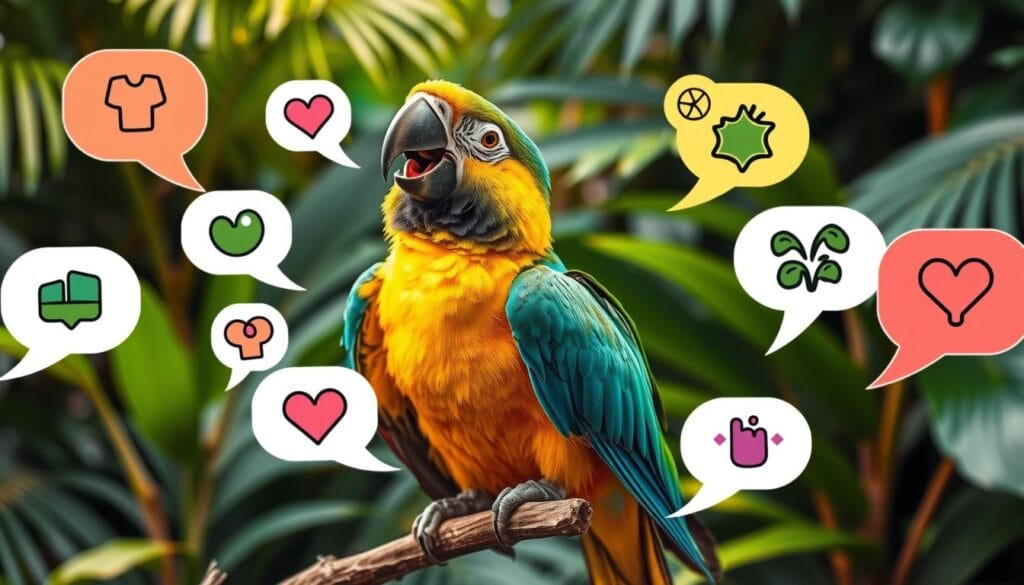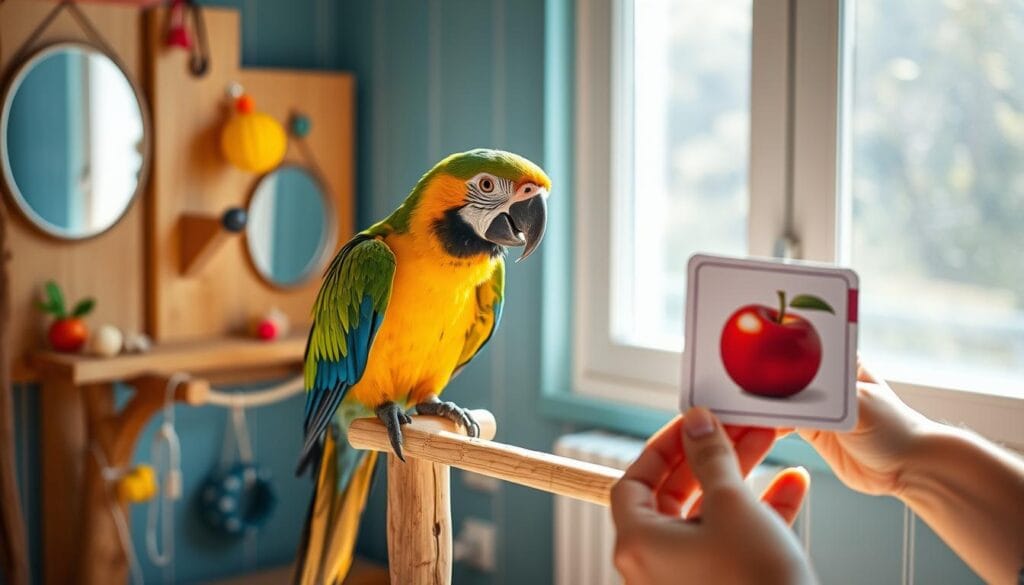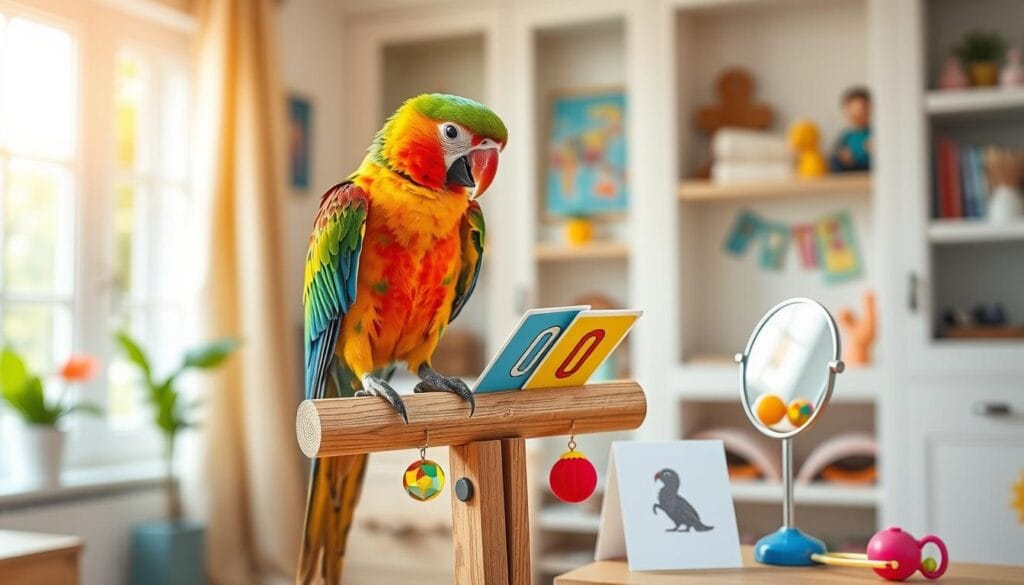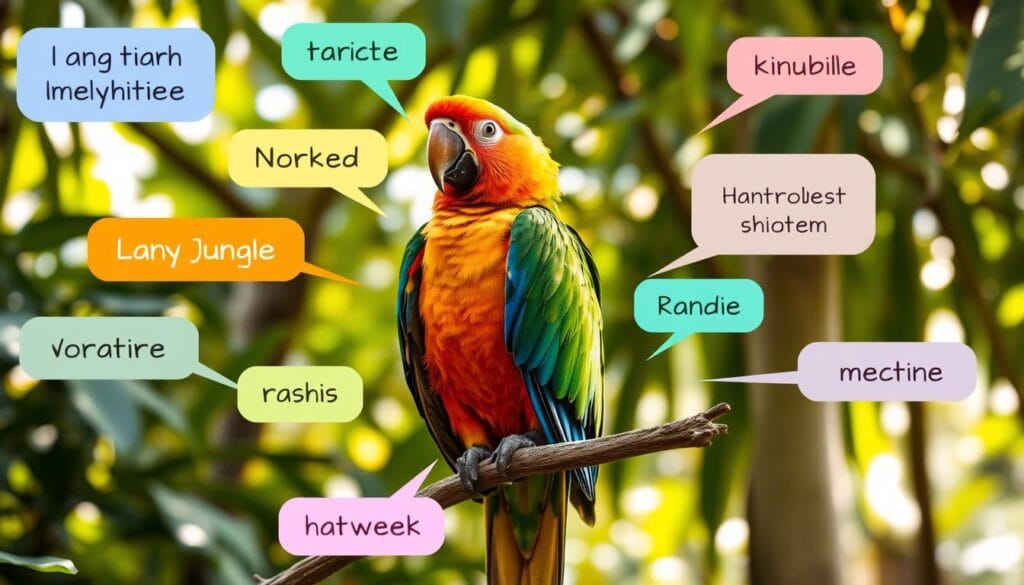Welcome to our guide on training a parrot to talk. With patience and consistency, you can teach your parrot to mimic human speech. Our goal is to give you a detailed guide to help you succeed in teaching your parrot to speak.
You’ll learn how to create a learning-friendly environment for your parrot. We’ll cover the basics of training, including the tools you’ll need. Plus, we’ll share tips on growing your parrot’s vocabulary.
Our guide is easy to follow, with clear steps and practical advice. It’s perfect for both new and experienced parrot owners. We’ll help you reach your goal of training a parrot to talk.
Introduction to Parrot Speech Training
In this guide, we’ll take you through training a parrot to talk. You’ll learn about parrot speech capabilities and how to keep expanding their vocabulary. We’ll show you how positive reinforcement and repetition can help your parrot learn and practice speaking.
Table of Contents
Understanding Parrot Speech Capabilities
Teaching your parrot to talk is an exciting journey. Parrots are famous for mimicking human speech. With the right talking parrot lessons, your parrot can learn to communicate like never before. To make a parrot talk, you must know how they learn and which species are best at it.
Some parrots, like African Greys and Amazon parrots, are great at talking. They have the smarts, social skills, and physical traits to mimic speech well. Learning about parrot vocalization helps you train your parrot better, matching your approach to their needs.
- Species: Some parrots, like African Greys and Amazon parrots, are more likely to talk.
- Age: Young parrots are more open to learning.
- Environment: A lively, interactive space helps your parrot develop its talking skills.
By focusing on talking parrot lessons and parrot communication skills wisely, you can teach your parrot to talk well. Be patient, consistent, and positive. This will help your parrot become a skilled talker.
Creating the Perfect Learning Environment
To help your parrot learn and thrive, you need to create a good learning space. This means a quiet, distraction-free area for parrot vocalization training. A calm place helps your parrot feel at ease and confident, which is key for training.
Think about setting up a special training area in your home. It should be away from loud rooms and distractions.
For speaking parrot techniques, social interaction is very important. Your parrot will learn to mimic your voice and respond to commands when it feels close to you. Spend quality time with your parrot, doing things like playing with toys or cuddling. This builds trust and confidence, making training more effective.
Here are some tips for a positive learning environment for your parrot:
- Provide a variety of toys and activities to keep your parrot engaged and stimulated
- Use positive reinforcement techniques, such as treats and praise, to encourage good behavior
- Set aside dedicated time for training and interaction with your parrot
By following these tips and creating a good learning environment, you’ll help your parrot learn and grow. Be patient, consistent, and positive, and you’ll see your parrot’s parrot vocalization training and speaking parrot techniques improve.
With the right environment and training, your parrot can become a skilled and confident speaker. Remember, every parrot is different. Be ready to adjust your approach as needed to meet your parrot’s unique needs and personality.
Essential Tools and Materials for Training a Parrot to Talk
To train your parrot to talk, you need the right tools and materials. Start with positive reinforcement like using treats and rewards. This builds a strong bond and makes training easier.
You’ll need tools like recording devices and training aids. They help track your parrot’s progress and give feedback. For example, a recording device can play back your parrot’s sounds to teach new words.
Training Treats and Rewards
Training treats and rewards are key. They motivate your parrot and make training positive. Try sunflower seeds, nuts, or dried fruits as treats. Verbal praise and affection also work well.
Recording Devices and Training Aids
Recording devices and aids are very helpful. They let you track your parrot’s progress and give feedback. Use a voice recorder to teach new sounds. Flashcards and interactive toys make training fun.
With the right tools, training becomes more efficient. Always use positive reinforcement and praise your parrot. With patience and the right training, your parrot can learn to talk well. Taking talking parrot lessons can also help.
| Tool | Description |
|---|---|
| Recording Device | Used to capture and play back your parrot’s vocalizations |
| Training Aids | Used to engage and motivate your parrot during training sessions |
| Training Treats | Used to reward and motivate your parrot during training sessions |
Building Trust With Your Parrot
To develop strong parrot communication skills, you need to bond with your bird. This bond is key for successful training and learning how to make a parrot talk. Spend quality time with your parrot, doing activities that encourage social interaction and positive reinforcement.
Having a daily routine makes your parrot feel secure and builds trust. Use this routine to teach new words and phrases. Reward your parrot with treats and praise when they repeat your words, encouraging them to keep learning.
Here are some tips to help you build trust with your parrot:
- Be patient and gentle when handling your parrot
- Provide a nutritious diet and a clean, comfortable environment
- Engage in play and social activities with your parrot regularly
- Use positive reinforcement techniques, such as treats and praise, to encourage good behavior
By following these tips and spending time with your parrot, you can build a strong bond. This will improve your parrot’s communication skills. It will also make teaching your parrot to talk more rewarding.

With patience, consistency, and positive reinforcement, you can enhance your parrot’s communication skills and teach them to talk. Stay calm, gentle, and supportive during training. This will help you build a strong, trusting relationship with your parrot.
| Trust-Building Activities | Frequency | Duration |
|---|---|---|
| Social Interaction | Daily | 30 minutes |
| Playtime | Daily | 30 minutes |
| Training Sessions | 3-4 times a week | 15-30 minutes |
Basic Training Techniques for Parrot Speech
Training a parrot to talk starts with simple words and phrases. This builds a strong foundation for your parrot’s speaking skills. Begin by choosing easy words to pronounce and repeat them often.
Proper pronunciation is key when teaching a parrot to talk. Speak clearly and slowly to help your parrot learn. Repeat words and phrases many times and encourage your parrot to mimic you. Being consistent is important, so set a regular training schedule.
- Starting with simple words and phrases
- Using positive reinforcement, such as treats and praise
- Repeating words and phrases multiple times a day
- Encouraging your parrot to mimic you
By following these steps and staying consistent, you can help your parrot develop strong speaking skills. This will make your relationship with your parrot more engaging and interactive.
Advanced Speech Training Methods
As you move forward in parrot vocalization training, it’s key to use advanced techniques. These methods challenge your parrot and help them learn complex speech. Start by teaching your parrot to mimic sentences. This will boost their vocabulary and how well they pronounce words.
Try breaking down sentences into smaller phrases. Then, slowly add more complexity as your parrot gets more confident.
Some effective methods for advanced speech training include:
- Repeating phrases and sentences multiple times to reinforce learning
- Using visual aids, such as flashcards or pictures, to associate words with meanings
- Engaging in conversations with your parrot, responding to their vocalizations, and encouraging them to respond back
By using these advanced techniques, you can help your parrot learn more words. This will also make their communication skills better. Always be patient and consistent. Advanced speech training takes time and effort.
With the right techniques and dedication, you’ll have a more engaging and interactive relationship with your parrot.

As you keep challenging your parrot with advanced speech training, you’ll see big improvements. They’ll be able to mimic sentences better and have real conversations. This will not only make your bond stronger but also give you a sense of pride in their abilities.
| Training Method | Description |
|---|---|
| Repetition | Repeating phrases and sentences multiple times to reinforce learning |
| Visual Aids | Using flashcards or pictures to associate words with meanings |
| Conversational Engagement | Engaging in conversations with your parrot, responding to their vocalizations, and encouraging them to respond back |
Troubleshooting Common Training Challenges
Training your parrot to talk can face many challenges. It’s key to find the cause and use the right strategies. With patience, consistency, and the right approach, talking parrot lessons can be fun and rewarding.
Common challenges include resistance, pronunciation issues, and hitting a training plateau. To tackle these, adjust your training, use positive reinforcement, and make learning fun for your parrot.

To beat resistance, figure out why your parrot is acting that way and change your training. For example, if they resist new words, try different methods like repetition or rewards. To fix pronunciation problems, practice with your parrot and give feedback. To get past a plateau, introduce new words or challenges to keep things exciting.
Here are some tips to tackle common training challenges:
- Be patient and consistent in your training approach
- Provide positive reinforcement and rewards
- Make the learning process engaging and enjoyable
- Adjust your training methods to address specific challenges
- Seek professional help if you’re experiencing persistent challenges
| Challenge | Solution |
|---|---|
| Resistance | Adjust training approach, provide positive reinforcement |
| Pronunciation issues | Practice proper pronunciation, provide feedback |
| Training plateaus | Introduce new words, phrases, or challenges |
By using these tips and knowing about common challenges, you can help your parrot succeed in talking parrot lessons. Stay patient, consistent, and positive, and you’ll be on your way to raising a talking parrot.
Maintaining and Expanding Your Parrot’s Vocabulary
To keep your parrot happy and smart, it’s key to grow their vocabulary. You can do this by practicing every day, introducing new words, and making training fun. This will boost your parrot’s parrot communication skills and strengthen your bond.
Introducing new words can be fun with positive rewards like treats and praise. You can also use flashcards to link words with pictures. To teach your parrot to talk, be patient, consistent, and creative.
Here are some tips to make training fun:
- Use a variety of toys and props to keep your parrot interested
- Play games that encourage your parrot to repeat words and phrases
- Keep training sessions short and fun to avoid overwhelming your parrot

By following these tips and staying committed, you can help your parrot become more skilled in communication. Always be patient and positive, and make learning a fun experience for both you and your parrot.
| Training Tip | Description |
|---|---|
| Daily Practice | Set aside time each day to practice with your parrot |
| Positive Reinforcement | Use treats and praise to encourage good behavior |
| Visual Aids | Use flashcards and other visual aids to help your parrot learn |
Conclusion: Your Journey to a Talking Parrot
As you finish this guide, remember that teaching your parrot to talk is a rewarding journey. It takes patience, dedication, and a strong bond with your feathered friend. By following the proven techniques in this article, you’ll help your parrot learn to talk and have fun conversations.
Keep up with your training routine and try new things that fit your parrot’s personality. With regular practice and positive feedback, you’ll see your parrot’s talking skills grow. This will bring you endless joy and show you how smart these birds are.
Enjoy every moment of this journey and celebrate when your parrot says its first words. Whether it’s “hello” or something more, each step will make you proud. It will also make your bond with your talking parrot even stronger. So, start this exciting adventure and see how much your parrot can say.

